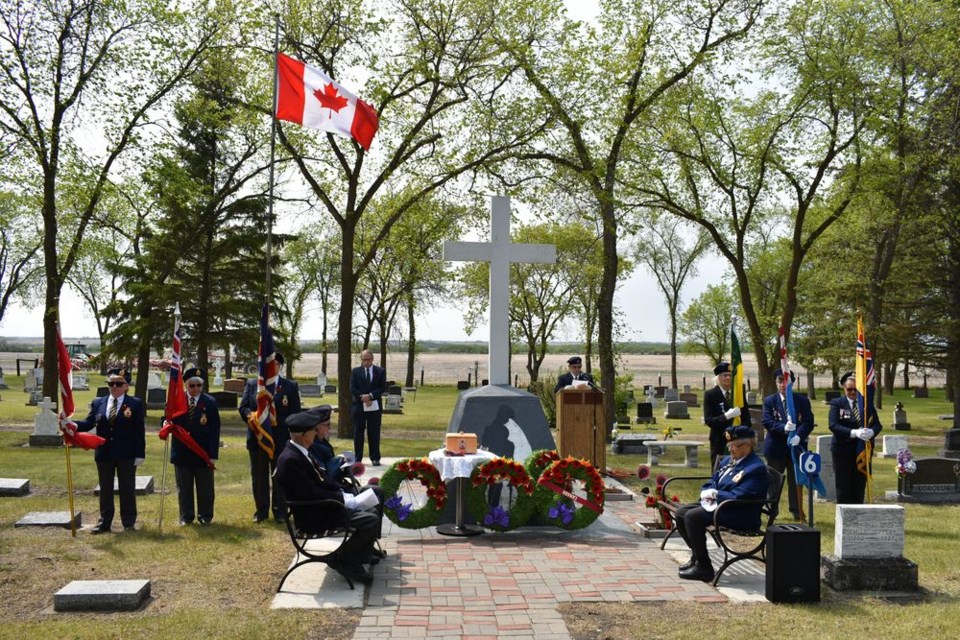The 75th anniversary of D-Day, the largest seaborne invasion in history (June 6, 1944), was observed by members of the Kamsack branch of the Royal Canadian Legion during its annual Decoration Day service on June 2.
Held at the Legion cenotaph at Riverview Cemetery in Kamsack, the service also included, for the first time, a scattering-of-the-ashes ceremony and later in the day at the Legion Hall several members and supporters were honoured.
As is the custom, the Decoration Day service began with the singing of O Canada and the playing of The Last Post and Reville. The Colour Party was brought forward to the music of bagpipes played by Keri Lindsay.
With Jim Woodward, Legion branch president, as emcee and with Rev. Stephen Ruten assisting, the program included a silence of remembrance, prayers, a Gospel reading and words of remembrance.
Wreaths were laid at the cenotaph by representatives of the governments of Canada and Saskatchewan and by the Kamsack Legion branch with Robert Boudreau assisting.
A total of 1.1 million Canadians served in the Second World War, including 106,000 in the Royal Canadian Navy and 200,000 in the Royal Canadian Air Force, Ruten said during the program. Of them, 42,042 were killed and 54,414 were wounded.
On D-Day, 14,000 Canadians landed on the beaches at Normandy, he said. About 450 airmen had jumped by parachute or landed by glider and 10,000 sailors were involved. A total of 340 were killed; 574 were wounded, and 47 were taken prisoner.
The Canadian Navy provided 109 vessels and 10,000 sailors as its contribution to the massive armada of 7,000 Allied vessels which had put to sea on D-Day, he said, explaining that the Canadian objectives were to establish a beachhead, capture three small seaside towns, advance 10 miles inland, cut the Caen-Bayeau highway, seize the Carpiquet airport west of Caen and form a link between the British beachheads of Sword and Gold.
The Third Canadian Division had progressed further inland than any of the Allies on D-Day.
During the first six days of the Normandy campaign, 1,017 Canadians died and by the end of the campaign, about 5,020 Canadians had been killed. About 5,400 Canadians are buried in Normandy.
In the two-and-a-half months of the Normandy campaign, Allied casualties totalled 210,000, while Canadian casualties totalled more than 18,000, including more than 5,000 dead. German casualties were 450,000.
“God wants us to be people who remember what is important from the past,” Ruten said. “Juno Beach is important to remember in its way. The Israelites were to remember the Passover and to celebrate every year. But this celebration that looked to the past, also looked to the future—to Jesus and what He would do. Paul calls Christ ‘Our Passover’.”
“With your presence, guide and help us to save succeeding generations from the scourge of war, which just in the past century has brought untold suffering to humanity,” it was said in prayer during the service. “Help us to reaffirm our faith in fundamental human rights, in the dignity and worth of every human person, in the equal rights of men and women and of nations large and small.
“Help us establish conditions where justice may prevail, where respect for the obligations arising from treaties and other sources of international law can be maintained, where freedom and a better standard of living may be for all. Help us to practice tolerance and to live together in peace with one another as good neighbours.”
A history of the scattering of ashes was read before Woodward and Ruten spread handfuls of ashes at the base of the cenotaph.
Woodward explained the scattering-of-the-ashes ritual, saying the ceremony had originated in Europe in 1936 at the unveiling of the Vimy Ridge Memorial for which the Canadian Legion had planned to attend because it would be dedicated to the more than 50,000 Canadians who had lost their lives in the First World War.
A British Legion custom had been to distribute small wooden crosses in memory of those fallen and following Armistice Day, they would be destroyed by burning, he said. The ashes from the crosses were placed in a small casket.
It was after the Second World War when it had been suggested by members of the Yorkton Legion that instead of throwing Remembrance Day wreaths into the garbage, they should be burned and the ashes scattered in the soldiers’ plot at the Yorkton Cemetery.
“This casket you see before you today being used in this ceremony is a replica of the original casket and will be used by the Kamsack branch,” Woodward explained. “Our ashes will be spread over the memorial bricks at the base of this cenotaph.”
Those attending the service were thanked by members and veterans of the Kamsack Legion for having participated in a program designed to remember those who had laid down their lives for freedom and for those veterans who have died since the war and whose bodies are buried at the veterans’ portion of Riverview Cemetery, it was said. “We keep this day because it is the anniversary of Decoration Day and we scatter the ashes of wreathes which were damaged at our last Remembrance Day service.”
Legion members and supporters were honoured during a potluck supper served at the Legion Hall that evening.
“It was a fantastic event,” Woodward said. “We enjoyed an out-of-this-world potluck supper.”
During the event, Woodward was presented with the Sovereign’s Medal for Volunteers by Sharon Rudy, the first vice-president of the Legion, and received a 55-year member’s bar.
Woodward presented five certificates of appreciation to: John Adamyk, Keri Lindsay, the Kamsack Times, Legacy Co-op and the Hiawatha chapter of the Eastern Star.



